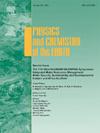Assessing ecological sustainability of the Narmada River using the macrophyte river index
IF 3
3区 地球科学
Q2 GEOSCIENCES, MULTIDISCIPLINARY
引用次数: 0
Abstract
Narmada River, one of the largest waterways in India, plays a critical role in supporting aquatic ecosystems. This study examines the relationship between macrophyte diversity and nitrogen levels across fifteen sampling stations (A1-A15) in the central India (Anuppur, Dindori, Mandla, and Jabalpur) during the pre-monsoon seasons. Three macrophyte indices like RMNI (River Macrophyte Nutrient Index), MIR (Macrophyte Index for Rivers), and RMHI (River Macrophyte Hydraulic Index) were employed to assess ecological conditions and water quality. A total of 20 macrophyte species from 14 families were identified, with Lemna minor, Potamogeton pectinatus, Polygonum persicaria, Ceratophyllum demersum, Persicum hydropiper, and Potamogenton natans being the most prevalent in nutrient-rich environments. The principal component analysis is conducted to identify the similarities in the variables and to extract the key factors that exhibit strong internal correlations while remaining distinct from other factors. The analysis revealed significant spatial variability across monitoring stations, with A-5, A-6, A-10, A-11, A-12, A-13, A-14, and A-15 exhibiting elevated orthophosphates concentration. Notably, station A5 showed moderate level of DO, BOD and COD, whereas sulfate was comparatively low. These findings underscore the heterogeneity of water quality conditions along the Narmada River and highlight the influence of localized anthropogenic inputs. The clustering analysis grouped stations on their ecological status, highlights variations in macrophytes indices and water quality parameters. This study highlights the macrophytes' utility as ecological indicators for assessing riverine nutrient dynamics and overall environmental health, and further emphasizing the need for site-specific interventions to mitigate pollution and enhance ecological resilience.
利用大型植物河流指数评估纳尔马达河的生态可持续性
纳尔马达河是印度最大的水道之一,在支持水生生态系统方面起着至关重要的作用。本研究考察了季风前印度中部(Anuppur、Dindori、Mandla和Jabalpur) 15个采样站(A1-A15)的大型植物多样性与氮水平之间的关系。采用RMNI (River macrophyte nutrition Index)、MIR (River macrophyte Index for Rivers)和RMHI (River macrophyte Hydraulic Index) 3个指数对生态条件和水质进行评价。在营养丰富的环境中,共鉴定出14科20种大型植物,其中以小叶菜(lena minor)、马铃薯(Potamogeton pectinatus)、桃蓼(Polygonum persicaria)、长叶菜(Ceratophyllum demersum)、胡椒桃(Persicum hydropiper)和马铃薯(Potamogenton natans)最为常见。进行主成分分析是为了确定变量之间的相似性,并提取出表现出强烈内部相关性的关键因素,同时与其他因素保持不同。分析显示,各监测站之间存在显著的空间差异,A-5、A-6、A-10、A-11、A-12、A-13、A-14和A-15正磷酸盐浓度升高。值得注意的是,A5站的DO、BOD和COD均为中等水平,而硫酸盐含量相对较低。这些发现强调了纳尔马达河沿岸水质条件的异质性,并突出了局部人为输入的影响。聚类分析对各站点的生态状况进行了分组,突出了大型植物指数和水质参数的变化。本研究强调了大型植物作为评估河流营养动态和整体环境健康的生态指标的效用,并进一步强调了对特定地点进行干预以减轻污染和增强生态恢复力的必要性。
本文章由计算机程序翻译,如有差异,请以英文原文为准。
求助全文
约1分钟内获得全文
求助全文
来源期刊

Physics and Chemistry of the Earth
地学-地球科学综合
CiteScore
5.40
自引率
2.70%
发文量
176
审稿时长
31.6 weeks
期刊介绍:
Physics and Chemistry of the Earth is an international interdisciplinary journal for the rapid publication of collections of refereed communications in separate thematic issues, either stemming from scientific meetings, or, especially compiled for the occasion. There is no restriction on the length of articles published in the journal. Physics and Chemistry of the Earth incorporates the separate Parts A, B and C which existed until the end of 2001.
Please note: the Editors are unable to consider submissions that are not invited or linked to a thematic issue. Please do not submit unsolicited papers.
The journal covers the following subject areas:
-Solid Earth and Geodesy:
(geology, geochemistry, tectonophysics, seismology, volcanology, palaeomagnetism and rock magnetism, electromagnetism and potential fields, marine and environmental geosciences as well as geodesy).
-Hydrology, Oceans and Atmosphere:
(hydrology and water resources research, engineering and management, oceanography and oceanic chemistry, shelf, sea, lake and river sciences, meteorology and atmospheric sciences incl. chemistry as well as climatology and glaciology).
-Solar-Terrestrial and Planetary Science:
(solar, heliospheric and solar-planetary sciences, geology, geophysics and atmospheric sciences of planets, satellites and small bodies as well as cosmochemistry and exobiology).
 求助内容:
求助内容: 应助结果提醒方式:
应助结果提醒方式:


